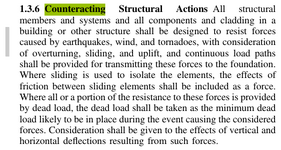Would appreciate some insight into uplift safety factor related to footings.
Here are the inputs:
Footing weight : 100 kN
Pedestal weight : 10 kN
Soil weight above the footing : 100 kN
Applied load on the pedestal : -25 kN
Buoyant load due to water pressure : -105 kN
What is the correct way to calculate the uplift safety factor using the 3 methods displayed below? Each method generates a different safety factor.
Method 1:
All upward acting total loads: U = -25-105 = -130 kN
All downward acting total loads: D = 100 + 10 + 100 = 210 kN
Uplift safety factor =D/(abs(U)) = 210/130 = 1.62
Method 2:
Total buoyant load: U = -105 kN
Total algebraic applied load at base of footing: D = 100 + 10 + 100 - 25 =185 kN
Uplift safety factor =D/(abs(U)) = 185/105 = 1.76
Method 3:
Total uplift load on pedestal: U = -25 kN
Total self weight at base of footing including buoyancy: D = 100 + 10 + 100 - 105 = 105 kN
Uplift safety factor =D/(abs(U)) = 105/25 = 4.2
Here are the inputs:
Footing weight : 100 kN
Pedestal weight : 10 kN
Soil weight above the footing : 100 kN
Applied load on the pedestal : -25 kN
Buoyant load due to water pressure : -105 kN
What is the correct way to calculate the uplift safety factor using the 3 methods displayed below? Each method generates a different safety factor.
Method 1:
All upward acting total loads: U = -25-105 = -130 kN
All downward acting total loads: D = 100 + 10 + 100 = 210 kN
Uplift safety factor =D/(abs(U)) = 210/130 = 1.62
Method 2:
Total buoyant load: U = -105 kN
Total algebraic applied load at base of footing: D = 100 + 10 + 100 - 25 =185 kN
Uplift safety factor =D/(abs(U)) = 185/105 = 1.76
Method 3:
Total uplift load on pedestal: U = -25 kN
Total self weight at base of footing including buoyancy: D = 100 + 10 + 100 - 105 = 105 kN
Uplift safety factor =D/(abs(U)) = 105/25 = 4.2

